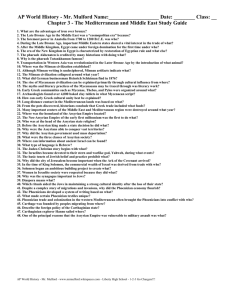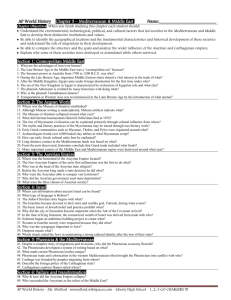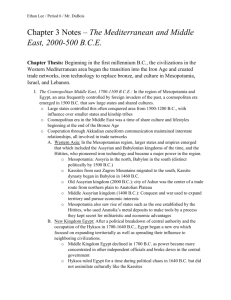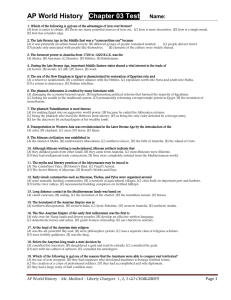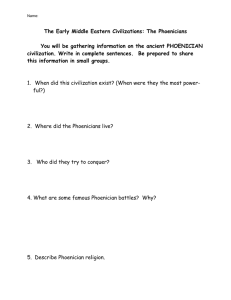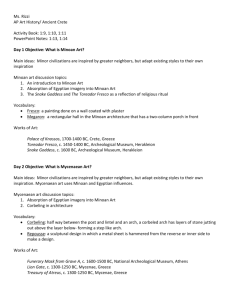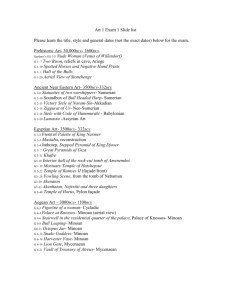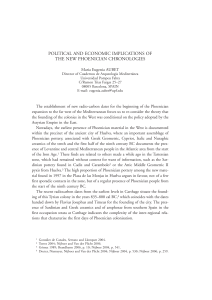AP Chapter 3 study guide-2 - Course
advertisement
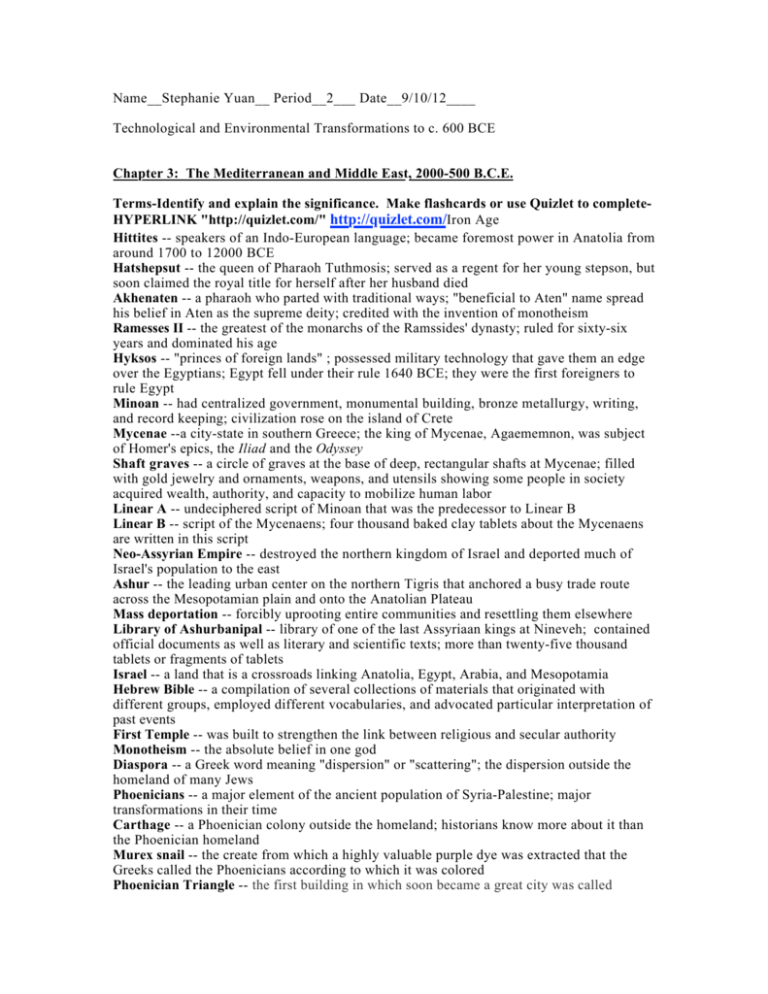
Name__Stephanie Yuan__ Period__2___ Date__9/10/12____ Technological and Environmental Transformations to c. 600 BCE Chapter 3: The Mediterranean and Middle East, 2000-500 B.C.E. Terms-Identify and explain the significance. Make flashcards or use Quizlet to completeHYPERLINK "http://quizlet.com/" http://quizlet.com/Iron Age Hittites -- speakers of an Indo-European language; became foremost power in Anatolia from around 1700 to 12000 BCE Hatshepsut -- the queen of Pharaoh Tuthmosis; served as a regent for her young stepson, but soon claimed the royal title for herself after her husband died Akhenaten -- a pharaoh who parted with traditional ways; "beneficial to Aten" name spread his belief in Aten as the supreme deity; credited with the invention of monotheism Ramesses II -- the greatest of the monarchs of the Ramssides' dynasty; ruled for sixty-six years and dominated his age Hyksos -- "princes of foreign lands" ; possessed military technology that gave them an edge over the Egyptians; Egypt fell under their rule 1640 BCE; they were the first foreigners to rule Egypt Minoan -- had centralized government, monumental building, bronze metallurgy, writing, and record keeping; civilization rose on the island of Crete Mycenae --a city-state in southern Greece; the king of Mycenae, Agaememnon, was subject of Homer's epics, the Iliad and the Odyssey Shaft graves -- a circle of graves at the base of deep, rectangular shafts at Mycenae; filled with gold jewelry and ornaments, weapons, and utensils showing some people in society acquired wealth, authority, and capacity to mobilize human labor Linear A -- undeciphered script of Minoan that was the predecessor to Linear B Linear B -- script of the Mycenaens; four thousand baked clay tablets about the Mycenaens are written in this script Neo-Assyrian Empire -- destroyed the northern kingdom of Israel and deported much of Israel's population to the east Ashur -- the leading urban center on the northern Tigris that anchored a busy trade route across the Mesopotamian plain and onto the Anatolian Plateau Mass deportation -- forcibly uprooting entire communities and resettling them elsewhere Library of Ashurbanipal -- library of one of the last Assyriaan kings at Nineveh; contained official documents as well as literary and scientific texts; more than twenty-five thousand tablets or fragments of tablets Israel -- a land that is a crossroads linking Anatolia, Egypt, Arabia, and Mesopotamia Hebrew Bible -- a compilation of several collections of materials that originated with different groups, employed different vocabularies, and advocated particular interpretation of past events First Temple -- was built to strengthen the link between religious and secular authority Monotheism -- the absolute belief in one god Diaspora -- a Greek word meaning "dispersion" or "scattering"; the dispersion outside the homeland of many Jews Phoenicians -- a major element of the ancient population of Syria-Palestine; major transformations in their time Carthage -- a Phoenician colony outside the homeland; historians know more about it than the Phoenician homeland Murex snail -- the create from which a highly valuable purple dye was extracted that the Greeks called the Phoenicians according to which it was colored Phoenician Triangle -- the first building in which soon became a great city was called Mabbonath ("lodging" in Phoenician); it was the most important of the three buildings forming the “Phoenician triangle” cited by Thucydides; the others were the Motya and Soluntum Neo-Babylonian kingdom -- rise of this empire started at the same time when the NeoAssyrian Empire began to decline Questions What does the story of Dido tell us about the spread of culture and civilization? What were the motivations behind migrations of peoples in antiquity? The island of Crete was home to one of the first Aegean civilizations, the Minoans. What was the legend of King Minos and the Minotaur? Brief facts only! What do the frescoes in the Minoan palaces depict? How are they different from the artwork of the Middle East? What does this represent? Answers: 1-2 sentences for most answers This story highlights the spread of cultural patterns from older centers to new regions, and the migration and resettlement of Late Bronze Age and Early Iron Age peoples in the Mediterranean lands and western Asia. • trade • resources • land • power • maze like labyrinth built by Daedalus to house the Minotaur • labyrinth under King Minos' palace • Minotaur was half-man, half-bull • • • • • • portray groups of women in frilly, layered skirts engaged in conversation or watching rituals or entertainment young acrobats vaulting over the horns and back of an onrushing bull Scenes of servants carrying jars and fishermen throwing nets and hooks from their boats elite than about the reality of daily toil. The stylized depictions of plants and animals on Minoan vases —plants with swaying leaves and playful octopuses whose tentacles wind around the surface of the vase frescoes depict beauty and order; do not show kings Middle Eastern art depicts scenes of chaos; clear figures of authority How did the Egyptian New Kingdom differ from the earlier periods? • • • • • • • • Although there are legends of King Minos, there is no evidence of Cretan political control of the mainland of Greece. Is there evidence of a cultural influence? Explain. What were the possible reasons for the fall of the Late Bronze Age Mycenaean civilization? What was a major “weapon” in the Assyrian Empire’s arsenal that involved many people? Explain The King was at the center of the Assyrian Empire. Explain. • • • • • • • • • • Egypt came under foreign rule for the first time then the reunification of Egypt under a native dynasty was accomplished by princes from Thebes a period of innovation Egyptian soldiers, administrators, diplomats, and merchants traveled widely, exposing Egypt to exotic fruits and vegetables, new musical instruments, and new technologies, such as an improved potter’s wheel and weaver’s loom one woman held the throne of New Kingdom Egypt ruler who departed from traditional ways ascended the throne: Akhenaten; promoted monotheism for Aten a new capital at modern-day Amarna the general Haremhab seized the throne and established a new dynasty, the Ramessides yes there is cultural influence in foreign lands pottery and other artworks have been found in Mesopotamia and Egypt political and economic collapse as migrants swarmed into one region, they displaced other peoples, who then joined the tide of refugees unidentified invaders peasant farmers, accustomed to defending themselves against marauders, provided the footsoldiers for the revival of Assyrian power in the ninth century B.C.E. All the land belonged to him, and all the people, even the highest ranking officials, were his servants Assyrians believed that the gods chose the king to rule as their earthly representative Explain the significance of the development of Jewish/Israeli monotheism. What is the significance of the Phoenician alphabet? What did Carthaginian foreign policy reflect? Judaism led to both Christianity and Islam, which spread throughout Europe and the Middle East respectively. Most of the world was ruled by religions descended from Jewish Monotheism. It is the basis for the English alphabet. An interest in protecting sea trade; keep the fleet big and bash any rivals II. Complete the following chart. Do not use complete sentences. Government System Egypt: Pharaoh as ruler; seen as god Priests high status Assyrian: Ruler seen as having been chosen by gods; all people were his servants All land belonged to him King was center of the universe Minoan: Kings ruled over citizens Centralized government Not much known; tablets say little about political and social structures Mycenaean: No mention of a king Israel: Unified monarchy David strengthened royal authority by making Jerusalem the capital Phoenician: Broken into city-states Two “judges” were elected from upper class families each year to serve as heads of state and carry out administratve/judicial functions Senate were people of leading merchant families who sat for life Inner ring of 30 senators made crucial decisions Leadership had an Assembly of citizens to elect public officials/vote on important issues Technology-Military and Non-Military Egypt: Potter’s wheel; weaver’s loom Assyrian: Chariots and horseback riding helped conquer other areas Minoan: High-quality indoor plumbing Boats Huge fortified citadels provided refuge in times of danger Mycenaean: Shaft graves-deep rectangular shafts containing the deceased; rounded by courtyards; Created writing form Linear B which used pictorial signs to represent syllables Boats Israel: First Temple (created by Solomon)-not really a technology, but a very significant construction because it strengthened the link between religious and secular authority and became a major pilgrimage site Chariots made Israel a regional power Phoenician: Created Phoenician alphabet based off of sounds Oared warships Economy based on… Egypt: Gold; bronze; semi-precious metals Assyrian: Iron; silver Minoan: Pottery; jewelry Mycenaean: Grain production; wool; pottery Israel: Gold; silver Phoenician: Obtained gold, precious stones and spices from trade Raw materials (cedar and pine, metals, incense, papyrus) Foodstuffs (wine, spices, salted fish) Luxury goods (textiles, carved ivory, glass) Status of Women Egypt: Slightly inferior to men but relatively equal in terms of other civilizations (women had more rights than most others) Assyrian: Not mentioned Minoan: Not mentioned, but women might have been seen as powerful due to their ability to reproduce; this is shown by how idols of women with animals represent fertility images (also shows power over animals) Mycenaean: Not mentioned Israel: Provided a vital portion of goods and services sustaining family As a result were respected and enjoyed relative equality w/ husbands, but couldn’t divorce or inherit property Some women reached positions of influence (e.g. Deborah the Judge who led troops in battle against Canaanites) Phoenician: Not mentioned Role of Civilians Egypt: Constructed monumental architecture such as pyramids; farmers; merchants; scribes Assyrian: Farmers; worked in the army; used to invoke fear (e.g. were thrown into fires); merchants; scribes Minoan: Farmers; fishermen; servants; merchants Mycenaean: Farmers, shepherds; scribes; built shaft graves, and citadels; merchants Israel: Building program est. by Solomon employing slaves and the compulsory labor of citizens Phoenician: Scribes; merchants; farmers; fishermen Themes Egypt Assyrian Minoan Mycenaea Israel Phoenicia n n Theme 2: Developm ent and Interaction s of Cultures Theme 3: StateBuilding, Expansion , and Conflict Theme 4: Creation, Expansion , and Interaction s of Economic Systems Theme 5: Developm ent and Transfo rmation of Social Structur es
